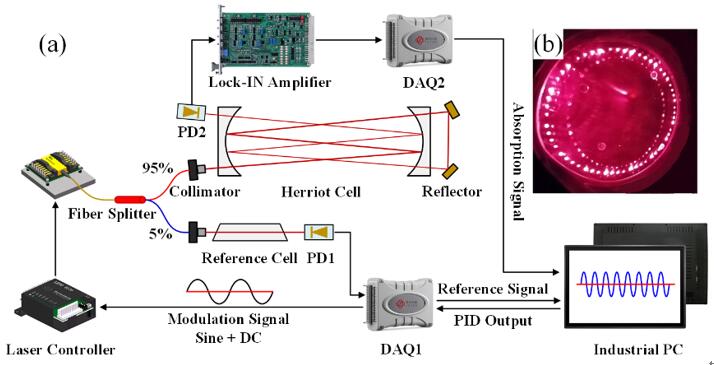
Recently, a research team led by Prof. GAO Xiaoming from the Anhui Institute of Optics and Fine Mechanics, Hefei Institutes of Physical Sciences, Chinese Academy of Sciences (CAS) found a new way to measure the atmospheric methane (CH4) and soil methane respiration using tunable laser absorption spectroscopy (TDLAS).
The related research was published in journal of Optics Express.
Controlling CH4 emissions is crucial in mitigating the greenhouse effect, as it has a short lifetime in the atmosphere. The CH4 cycle is affected by land use, which can either be a source or sink of CH4. To understand the contribution of different soils to this cycle, it's essential to measure CH4 fluxes in soils. One widely used technique for gas detection is TDLAS, offering high sensitivity, accuracy, selectivity, and fast response. Using multi-pass cells can increase detection sensitivity by extending the absorption light pathlength, but traditional Herriot cells suffer from low mirror utilization and require large absorption cells due to longer optical pathlengths.
In this research, scientists developed a novel methane (CH4) sensor using wavelength modulation spectroscopy with a multipass cell, which can accurately measure CH4 emissions from soil. The new technique uses a specially designed double-enhanced Herriot-type multipass cell, coupled with a fiber-coupled distributed feedback diode laser emission at 1653.74 nm, to achieve high accuracy and sensitivity.
They used various techniques such as double enhancement of the effective optical pathlength of the multipass cell, absorption line locking, laser intensity normalization, and temperature control to improve the performance of the sensor. The result is an incredibly low minimum detection limit of just 10 ppbv and a measurement precision of 6.4 ppbv.
The researchers tested the potential of the CH4 sensor for ecological applications by measuring the soil respiration of CH4 and monitoring CH4 levels in the atmosphere over a long period. This research could help to better understand the impact of different land use patterns on the CH4 cycle and ultimately contribute to mitigating greenhouse gas emissions.
"This work is a significant step forward in our ability to accurately measure CH4 emissions from soil, and it offers immense potential for further research into the role of soils in the CH4 cycle,” said WANG Ruifeng, first author of the paper.
This work was supported by the National Key Research and Development Program of China and the National Natural Science Foundation of China.

Schematic of the CH4 sensor (Image by WANG Ruilin)

Schematic of soil CH4 flux measurements and the results (Image by WANG Ruilin)